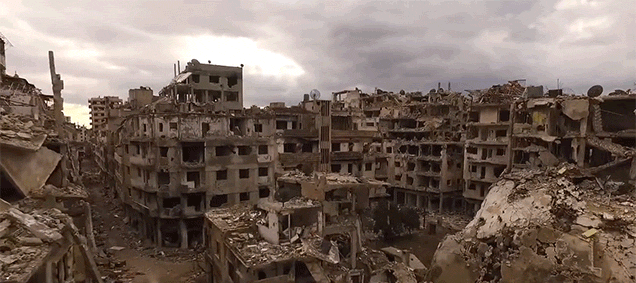
Though many trace the beginning of the ongoing conflict in Syria back to the Arab Spring protests of 2011, the seeds of war were sown as early as the late 1940's. In this article however, we will only go back a decade. Earlier dates will be discussed in future articles. The events that started a decade before the imposed war in Syria, which took place in the middle of March 2011, would send the country into a violent downward spiral.
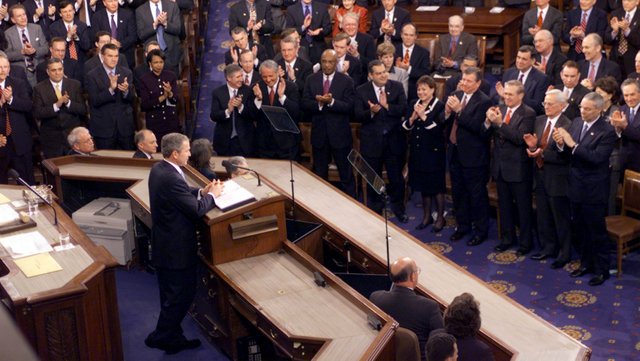
President Bush gives his State of the Union address on Capitol Hill Tuesday, Jan. 29, 2002. Bush fleshed out his vision for the war on terrorism beyond Afghanistan, to a dozen countries that he said harbor terrorists and “an axis of evil” of three more that seek weapons of mass destruction, including Syria. (AP/J.Scott Applewhite)
SYRIA – The fingerprints of U.S. imperialism can be found all over the manufactured insurrection in Syria, in keeping with the ultimate goal of destabilization and eventual “regime change” through fomenting a sectarian civil war. Former NATO commander Wesley Clark has gone on record as stating that Syria was on a list of targeted nations to be toppled by the U.S. as early as 2001. In 2002, former Secretary of State John Bolton gave a speech titled “Beyond the Axis of Evil” that listed Syria as a handful of nations that could expect to be targeted.
Fast forward to 2011, when an uprising was manufactured in the Syrian city of Dara’a, and Syrians desperate for economic change joined the calls for “freedom.” Mainstream media outlets have largely described the uprisings as being part of a “protest movement” made up of demonstrators who demand the ouster of Syrian President Bashar al-Assad. But in reality, the main organizers and leaders of this so-called protest movement have been revealed to be U.S.-backed insurgents and foreign militants who have been armed, trained and funded by U.S. and NATO proxies for the purpose of destabilizing Syria though sectarianism.
CIA-backed Muslim Brotherhood assets were already in place to snipe at both police and protesters the day the first demonstrations broke out. Since then, the CIA has funneled hundreds of billions of dollars, as well as staggering amounts of arms, to jihadist recruits, many of whom have poured into Syria from surrounding countries.
The narrative most commonly put forth in mainstream media portrays the Syrian conflict as a popular uprising. However, a closer examination of the events that occurred in Dara’a in March 2011 – commonly described as the beginning of the conflict – reveals substantial and compelling evidence that not only contradicts the mainstream media’s portrayal but also strongly suggests the involvement, both financially and militarily, of outside influences and actuators.

Dore Gold and Anwar Eshki shake hands at a CFR event, as Elliott Abrams looks on.
The evidence of such involvement has piled up in the years since the conflict started. In 2012, Saudi General Anwar Al-Eshki admitted in a BBC interview that his government had financed Salafist Muslim Brotherhood elements and had sent weapons to the Al-Omari Mosque, some of which were later discovered and seized by Syrian security forces. These Salafist elements went on to form the backbone of the “Free Syrian Army,” a guerrilla force that has the stated goal of bringing down Assad and his government.
The Salafists have done much to terrorize the civilian population of Syria. In Karak, a village near Dara’a, villagers were forced to join anti-government protests and remove photos of Assad from their homes. Those who refused were killed. “People want to go out and peacefully ask for certain changes, but Muslim Salafi groups are sneaking in with their goal, which is not to make changes for the betterment of Syria but to take over the country with their agenda,” one Syrian Christian leader told the International Christian Concern.
The following timeline portrays Syria’s descent into “civil war” as part of U.S.- and NATO-backed efforts to destabilize the country and achieve their ultimate goal of regime change.
Before the “revolution,” the U.S. makes an enemy out of Syria
2001: Shortly after the terrorist attacks of 9/11, a classified plot is revealed to U.S. Army General Wesley Clark. He is informed that the U.S. plans to attack and destroy the governments of seven countries for the purpose of intimidating terrorists: Iraq, Syria, Lebanon, Libya Somalia, Sudan and Iran.
<iframe width="500" height="375" src="
2002: U.S. Under Secretary of State John Bolton declares Syria a member of the “axis of evil” and warns that the U.S. will take action against countries in the axis.
2005: The U.S. State Department’s National Endowment for Democracy organizes and implements the “Cedar Revolution” in Lebanon – a movement directly aimed at undermining Syrian-Iranian influence in Lebanon in favor of Western-backed proxies.
Ziad Abdel Nour, an associate of Bush administration policymakers and president of the United States Committee for a Free Lebanon, admitted the following when asked about the future of Syria: “Both the Syrian and Lebanese regimes will be changed – whether they like it or not – whether it’s going to be a military coup or something else…and we are working on it. We know already exactly who’s going to be the replacements. We’re working on it with the Bush administration.”
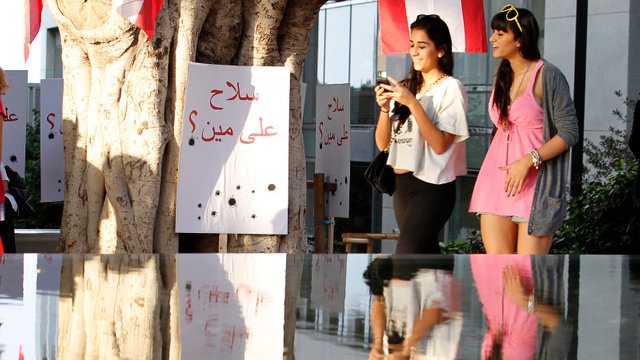
Lebanese activists stand near a banner that reads in Arabic:” towards whom is directed the weapon?", during a sit-in organized by various groups as they demand the government to take action against the widespread of uncontrolled weapons in Beirut, Lebanon, Wednesday, Sept. 15, 2010. A Western-backed alliance in Lebanon’s government, the March 14 coalition, named after a demonstration to demand Syria leave Lebanon, accused the militant group Hezbollah and its allies on Wednesday of trying to take the country back to the days before the 2005 “Cedar Revolution.” (AP/Hussein Malla)
2007: Seymour Hersh of the New Yorker reveals that the U.S., Israel and Saudi Arabia, as well as the Syrian arm of the Muslim Brotherhood, are assembling, arming, training and funding sectarian extremists, many of whom have direct ties to al-Qaeda. Their goal is to exploit the sectarian divide between Sunni and Shiite Muslims. Hersh’s report indicated that the extremists would be strategically located so that they would be able to cross into Syria.
2009: The Brookings Institution publishes a report titled “Which Path to Persia?” that details a “new American strategy for Iran.” In the report, the institute states the importance of neutralizing Syrian influence before any attack on Iran can be carried out.
2009: Top British officials tell former French Minister for Foreign Affairs, Roland Dumas, that they were “preparing something in Syria.” He claimed they were organizing an “invasion of rebels” in a 2013 interview with French TV station LCP. The “revolution” begins – armed rebels masquerade as “protesters.”
<iframe width="560" height="315" src="
Jan. 17, 2011: Prior to the anti-government insurgency, and in response to popular pressure, the Syrian government “increased the heating oil allowance for public workers by 72 percent to the equivalent of $33 a month.”
Late January 2011: A page is created on Facebook called The Syrian Revolution 2011. It announced that “Day of Rage” protests would be held on Feb. 4 and 5.
Feb. 4-5, 2011: The “Day of Rage” protests that were called for on Facebook fizzle and are largely uneventful.
Feb. 9, 2011: The government lifts its ban on Facebook, Youtube, and Twitter. The bans had been in place since 2007.
Feb. 13, 2011: The government, through its newly-established National Social Aid Fund, starts offering transfer payments to help Syria’s 420,000 poorest families.
Feb. 15, 2011:The Syrian government “reduced duties on a range of basic foodstuffs, including rice, tea, powdered milk, coffee, and bananas. It also lowered taxes on vegetable oil, margarine, unroasted coffee, and sugar.”
March 20, 2011: A courthouse is torched in Dara’a.
“Protesters then forced their way through security barriers and headed toward the Baath Party headquarters and other government symbols. In addition to the party headquarters, protesters burned the town’s main courthouse and a branch of the SyriaTel phone company, which is owned by Rami Makhlouf, a cousin of the president.”
<iframe width="500" height="375" src="
The governor’s office and another SyriaTel office are also set alight: “A front-page story in the government-run Teshreen daily on Tuesday, Dara’a cleric Sheik Ahmad al-Sayasina was quoted as saying, “There were elements from outside Dara’a determined to burn and destroy public property … These unknown assailants want to harm the reputation of the sons of Hauran.” The cleric reportedly said, “The people of Dara’a affirm that recent events are not part of their tradition or custom.”
March – May 2011: “There were signs from the very start that armed groups were involved,” journalist and author Robert Fisk recalls after seeing a tape from “the very early days of the ‘rising’ showing men with pistols and Kalashnikovs in a Daraa demonstration. ”He recalls another event in May 2011, when “an Al Jazeera crew filmed armed men shooting at Syrian troops a few hundred meters from the northern border with Lebanon, but the channel declined to air the footage.”
“Even U.S. officials, who were hostile to the Syrian government and might be expected to challenge Damascus’s view that it was embroiled in a fight with armed rebels, acknowledged that the demonstrations weren’t peaceful and that some protesters were armed.”
March 23, 2011: After sending a delegation to Dara’a to investigate events, Syrian President Bashar al-Assad sacks the city’s unpopular governor, Faysal Kalthum, and orders the release of the fifteen teenagers who were detained for writing graffiti that featured anti-government slogans.According to at least two dissident websites, protesters had given the Syrian government until the morning of March 25 to meet a list of demands that were relayed to the president by his delegation. The demands included lifting a 48-year-old emergency law and releasing all political prisoners. If the demands were not met, they said March 25 would become the “Friday of the Martyrs” throughout the country.
Weapons that were stored in the Al-Omari mosque in Dara’a are seized. Anwar Al-Eshki, a former major general of the Saudi military and president of the Center for Strategic Studies in Saudi Arabia, gives an interview in which he reveals information about the first days of the Syrian crisis and confirms his connections with “protesters.”
March 25, 2011: From a letter published by Father Frans van der Lugt (later murdered by extremists in April 2014): “From the start, the protest movements were not purely peaceful. From the start, I saw armed demonstrators marching along in the protests, who began to shoot at the police first. Very often the violence of the security forces has been a reaction to the brutal violence of the armed rebels.”
A large pro-Assad rally is held in Damascus on March 25 as well.
<iframe width="500" height="281" src="
March 2011: Wikileaks reveals that “protesters,” allegedly 500 of them, will receive payment to take up arms.”
Early April, 2011: Massive demonstrations are held in support of Assad and to reject extremists.
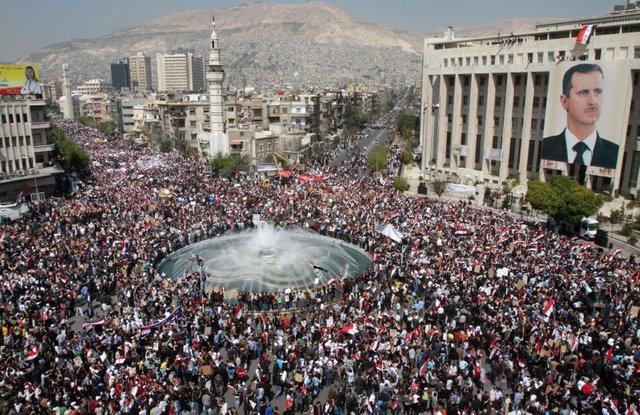
An estimated 2 million Syrians marched in Damascus, Syria in support of President Bashar al-Assad on March 29th, 2011.
April 10, 2011: Nine Syrian soldiers are ambushed on a bus and fatally shot. Syrian soldiers and police officers are assassinated throughout April. Opposition forces claimed they were executed for desertion from the Syrian army, although video footage from their funerals refutes this claim.
Assad supporters rally against opposition, political reform arrives
June 15, 2011:A 2.3-km-long Syrian flag is unfurled by thousands of Assad supporters in Damascus.
<iframe width="500" height="375" src="
June 20, 2011:Assad announces a national dialogue to begin a process of constitutional reform. One of the major demands is for an end to the constitutional privileges afforded to the Ba’ath party.
November 2011: Assad supporters hold more marches, most notably in the cities of Homs and Dara’a. Both cities are described by some as the “capital” and “birthplace,” respectively, of the so-called “revolution.”
<iframe width="500" height="375" src="
Feb. 26, 2012: A constitutional referendum is held, asking the electorate whether they would approve of new changes that were proposed for Syria’s Constitution. Eighty-nine percent of the electorate voted in favor of the changes, which included significant reforms to the presidential election process. The changes removed the institutionalized dominance of the Ba’ath party, as well as allowed for elections to be contested between multiple candidates.
May 7, 2012: Syria’s parliamentary elections are held according to the new constitution to determine the composition of the 250-seat People’s Council. The elections see a 51-percent participation rate among the electorate. The National Progressive Front, a political alliance of Syrian parties that includes the Ba’ath party, wins 168 seats. An opposition coalition of political parties called the Popular Front for Change and Liberation contests the NPF, but wins just five seats. CIA confirmed providing arms to anti-Assad rebels, presidential election follows
June 21, 2012: It is reported that the CIA is secretly providing arms to Syrian rebels through the Turkish border.
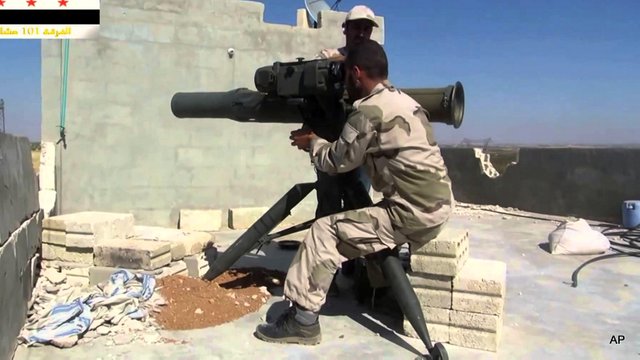
A well-equipped Syrian rebel using a US-made BGM-71 TOW against the Syrian Arab Army. (YouTube Screenshot)
August 2012: According to a Department of Defense document released by Judicial Watch, the West, Gulf countries and Turkey support the opposition, while China, Russia, and Iran support Assad’s regime. The document also confirms that Syria’s Muslim Brotherhood and AQI (also known as al-Qaeda) are responsible for driving much of the ongoing insurgency in Syria.
June 4, 2013: Data provided to NATO indicates that 70 percent of Syrians are in support of the Assad-led government.
June 3, 2014: The first multi-candidate presidential election in Syria is held. It is contested between three candidates: the incumbent President Assad, Hassan Al Nour and Maher Al Hajjar. Assad wins with 88.7 percent of the vote.
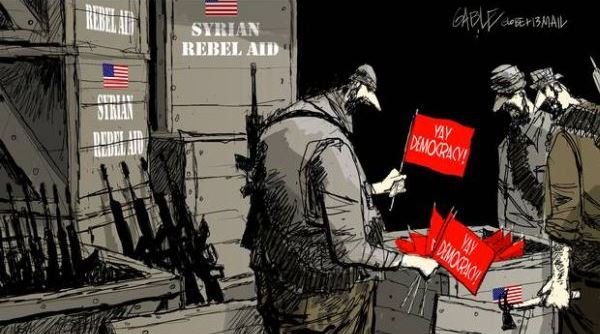
Image Credit
I still remember when I first knew for sure that the Arab Spring was just another colour revolution. I was watching an interview with a Syrian "activist" and started talking about the government hacking their social media. The reporter asked if he was worried about it and he calmly replied " We've got better hacking resources". Here was a guy casually dismissing the threat of a nation-state cyber-attack.
No doubt about it a classic de-stabilization campaign.
Downvoting a post can decrease pending rewards and make it less visible. Common reasons:
Submit
That's actually pretty impressive that you were able to pickup on that.. the media did such a good job of confusing people that even those who lived in Syria weren't really sure what was going on in the very beginning. They realized soon enough that this was all staged and I actually have an article that I will be uploading on steemit tomorrow that goes into depth about what took place early on.
Believe it or not, till now I still hear people repeating the same propaganda they heard on TV that this was a peaceful uprising that turned into a bloody conflict between the civilians and state police and military but that isn't what happened. In one of my articles that I posted on steemit I talked about how the US was training "activists" a few years prior and getting them ready to do pretty much what these fake activists did which is spread false information meant to demonize the Syrian government via social media and even on mainstream media.
Downvoting a post can decrease pending rewards and make it less visible. Common reasons:
Submit
Once I learned about the Orange revolution in Ukraine, and then all the other colour revolutions starting with the first one perpetrated against Serbia. Everybody always spouts propaganda thats how you find out what narrative is being pushed.
Downvoting a post can decrease pending rewards and make it less visible. Common reasons:
Submit
I wish the SAA and her allies continued success. May all the outside proxy mercenaries be defeated with the least damage to Syria!
Downvoting a post can decrease pending rewards and make it less visible. Common reasons:
Submit
Thank you so much! I have faith in them, they have lasted over 6 years fighting night and day against hundreds if thousands of foreign armed mercenaries with all of their might. Their fight against terrorism and imperialism won't end in vain.
Downvoting a post can decrease pending rewards and make it less visible. Common reasons:
Submit
Great work Sarah, i appreciate the effort nd details
Downvoting a post can decrease pending rewards and make it less visible. Common reasons:
Submit
My pleasure, thank you.
Downvoting a post can decrease pending rewards and make it less visible. Common reasons:
Submit
Such loss of life in promoting peace. USA is far away across Atlantic from the conflict zone but Europe is paying the price with unprecedented inflow of refugees
Downvoting a post can decrease pending rewards and make it less visible. Common reasons:
Submit
Well, that's the thing... the "promoting peace" or humanitarian intervention that the US uses as an excuse is just that. It is not the real reason why it invaded Syria and tried to carry out "regime change". Absolutely, many lives have been lost, many refugees created, a ton of infrastructure destroyed.. all under the pretense of bringing Syria democracy and liberty which it already was not lacking.
Downvoting a post can decrease pending rewards and make it less visible. Common reasons:
Submit
Incredibly thorough. Great work, looking forward to more. 100% upvote
Downvoting a post can decrease pending rewards and make it less visible. Common reasons:
Submit
Thank you! I greatly appreciate your feedback and upvote.
Positive and encouraging comments such as yours really motivate me to continue to share my articles here.
Thank you again! I'll follow you. :-)
Downvoting a post can decrease pending rewards and make it less visible. Common reasons:
Submit
What a jewel of research!
Followed!
Downvoting a post can decrease pending rewards and make it less visible. Common reasons:
Submit
Thank you! I greatly appreciate it. I'm glad you liked it.
Downvoting a post can decrease pending rewards and make it less visible. Common reasons:
Submit
Very well-written and well-sourced article. Our prosecution of war in Syria both directly and through our proxies is, and has been, an absolute disgrace. You cited one excellent Seymour Hersh piece in your essay. He has written several on the Syrian conflict that are quite illuminating. In 2013 and 2014 he published, Whose Sarin? and The Red Line and the Rat Line, both of which were published by the London Review of Books and address the alleged use of chemical weapons by Assad.
https://www.lrb.co.uk/v35/n24/seymour-m-hersh/whose-sarin
https://www.lrb.co.uk/v36/n08/seymour-m-hersh/the-red-line-and-the-rat-line
More recently Hersh again wrote of alleged chemical attacks carried out by Assad in early 2017. This time the London Review of Books refused to publish Hersh's piece, despite having vetted it and paid him for it. He was forced to publish in Germany's Die Welt.
https://www.welt.de/politik/ausland/article165905578/Trump-s-Red-Line.html
The unfortunate truth is that Pulitzer-award winning journalist Seymour Hersh can't get his meticulously sourced articles published in the United States because they conflict with narrative of the DC/Media establishment. They want war in Syria, and everywhere else, and do their best to silence voices of reason like Hersh and Sarahabed. Thanks for bringing some light to the issue.
Downvoting a post can decrease pending rewards and make it less visible. Common reasons:
Submit
Thank you! The truth is hidden under many layers of propaganda and lies unfortunately but its our duty as concerned citizens of this world to make every effort to uncover the truth and share it with everyone.
Downvoting a post can decrease pending rewards and make it less visible. Common reasons:
Submit
This is a great grandfather complete.
I hope you will follow us and thank you
Downvoting a post can decrease pending rewards and make it less visible. Common reasons:
Submit
Thank you!
Downvoting a post can decrease pending rewards and make it less visible. Common reasons:
Submit
meep
Downvoting a post can decrease pending rewards and make it less visible. Common reasons:
Submit
lol well meep to you too :-)
Downvoting a post can decrease pending rewards and make it less visible. Common reasons:
Submit
meep
Downvoting a post can decrease pending rewards and make it less visible. Common reasons:
Submit